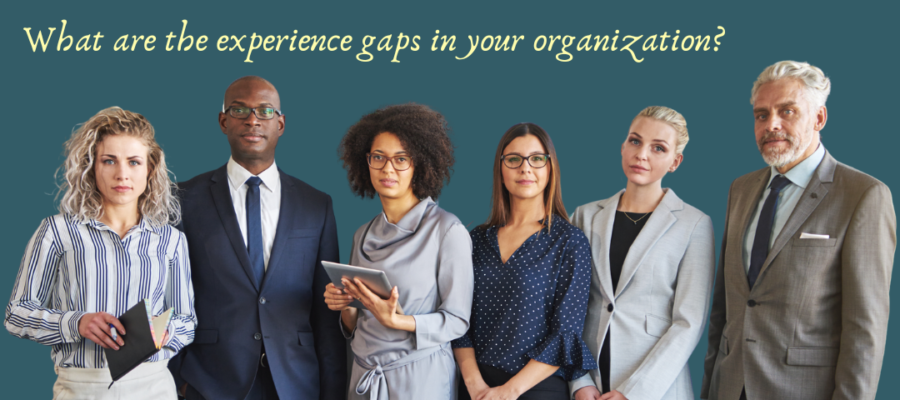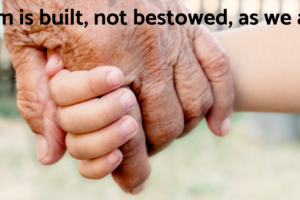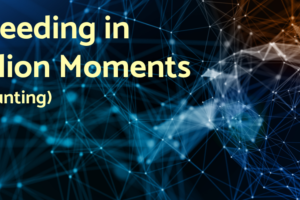Elderships: Filling the Experience Gaps in Your Organization
In the work team photo above, which member(s):
- Founded the company?
- Served in the military and led a helicopter rescue team in a combat zone?
- Wrote the programming language used in the team’s current project?
- Contribute the most innovative ideas on how their new product will solve customers’ problems?
- Talk most during team meetings?
- Has the broadest network of potentially useful resources within and outside their industry?
- Grew up in poverty, got into an inner city arts academy, and was a professional dancer before joining the team?
- Take a leadership role in making sure all members express their project-related ideas fully?
- Sense and make sure the team provides support for members’ personal issues?
Did you guess the older looking man as the founder? The person with the most connections? Did you pick the younger male as the programmer? The youngest woman as the dancer?
What kind of business project are they working on together? Did your assumptions on that point affect your guesses?
Okay, in one sense, these are trick questions; that’s just a stock photo (via Canva-for-Work).
But you should take the exercise seriously. As you read on, consider what your answers may reveal about age and experience diversity gaps in your organization.
Now, before we get to my proposal for “Elderships” to help you fill those gaps, let’s take a quick look at the business case for doing so and then bust a few myths about older workers that might be holding you or your organization back from actively recruiting and retaining them.
Why age/experience diversity matters to your business
One view of the age diversity benefit to business focuses on the “brain drain” caused by long term workers retiring and taking their knowledge and experience with them. As a Monster.com article points out, when smaller businesses or teams, “lose a valuable older worker, it’s a much bigger hit.”
From the recruiting perspective, it may be a simple matter of necessity to start looking for older workers. A U.S. Bureau of Labor Statistics report projects that nearly a quarter of the labor force will be aged 55 and older by 2018 — and that’s the only age group that has been growing over the last decade.
A more positive look at the business case for elderships finds research supporting the value of multi-generational work teams:
One research study found that the relative productivity of both older and younger workers is higher in companies that utilize mixed-age work teams than in companies that do not. Another study found that age diversity within a team was positively related to performance for groups that are involved in performing complex decision-making tasks.”
AARP | Disrupting Aging in the Workplace
All of these take too narrow a view, however. If we focus less on chronological age and more on the breadth of knowledge and experience that an older person brings to an organization, the benefits of diversity grow exponentially.

One of my favorite books is Organizing Genius, The Secrets of Creative Collaboration, by Warren Bennis and Patricia Ward Biederman, in which the authors examine the traits of spectacularly successful working groups, including Disney, Xerox PARC, Lockheed’s Skunk Works, and the Manhattan Project. The chapter on Xerox PARC describes the team that invented personal computers; yes, the ones that became both the Apple Macintosh and Microsoft Windows PC. Focusing on Alan Kay in particular, they quoted Steve Jobs:
‘Creativity is just connecting things. When you ask creative people how they did something, they feel a little guilty because they didn’t really do it, they just saw something. It just seemed obvious after a while. That’s because they were able to connect experiences they’ve had and synthesize new things. . . .’”
And here’s the killer part of Jobs’ creativity theory for our purposes:
‘And the reason they were able to do that was they’ve had more experiences or they have thought more about their experiences than other people.’”
The authors summed this up, observing about Alan Kay:
Exposed to art, music, and science from birth and a voracious and far-ranging reader, Kay had a vast number of experiential dots to connect.”
Organizing Genius (1997 paperback ed.), p. 66 (bold emphasis added).
Does that last part cast my questions about the “team photo” above in a different light? Do the ones about past experience with a rescue helicopter team, arts academy, overcoming poverty, and having a network outside their current industry make more sense?
My point here is that chronological age diversity for its own sake may not be the key to building more innovative and productive teams or companies. But accumulating “experiential dots” takes time. Thinking about those experiences and how they could connect takes time. As the AARP report put it (my emphasis):
Experience increases with age; it does not reach a certain level and then cease to be important.”
No doubt many teenagers have more experience with computer languages than I’m ever likely to gain. But I’ve had a half-century longer to accumulate personal and professional experiences, overcome setbacks, raise a family. I use my own example here, simply because it’s the one I know best. I’ve been well-off financially and survived on food stamps (twice). Along the way, I’ve built a specialty appeals practice within a mid-sized law firm, founded solo consulting practices, run small businesses, and helped create a social media network that’s now part of a Fortune 500 company. As a kid I played on various sports teams and later coached my kids’ teams; went from Boy Scout to adult leader. In many of these settings, I’ve collaborated with others as the newbie, a team member, or leader.
Most importantly, I think, a person my age has had decades to think about these disparate personal and professional experiences. And from that, learn how they can often be connected in interesting and unexpected ways to create new solutions for the next problem.
And when a work team includes members of different ages, generations even, this effect can be multiplied, again put nicely in the AARP report:
A workplace with millennials, Gen Xers, baby boomers,and the Silent Generation offers a unique opportunity for varied perspectives and approaches to day-to-day work.”
It bears emphasis that each of these generations brings a unique perspective that cannot be supplied by the others. We’ll come back to how teams can get the most out of collaborating across generations. For now, you should be seeing the business case for creating age and experience diversity in yours.

Busting some myths about older workers
The myths are many and time is precious, so here’s a short list of research-backed findings about the work-related qualities of older folks and why elderships can have a broad-reaching benefit:
- Human brains continue to grow new neurons and new neural pathways, thus growing their capacity to learn new information, connect it with past learning, and acquire more skills, throughout life. There are whole books collecting neuroscience research on the continuation of neurogenesis and neuroplasticity into old age, but two I recommend are, Healthy Brain, Happy Life: A Personal Program to Activate Your Brain and Do Everything Better, by Wendy Suzuki (2015). and The Secret Life of the Grown-up Brain: The Surprising Talents of the Middle-Aged Mind, by Barbara Strauch (2010).
- You’ve heard of people mellowing with age, but it turns out there’s plenty of research confirming what researchers call the “age-related positivity effect.” On average older people tend to focus more on positive information and emotions. Reed & Carstensen, The Theory Behind the Age-Related Positivity Effect (2012), https://www.ncbi.nlm.nih.gov/pmc/articles/PMC3459016/ (noting the evidence suggests that “older adults’ … apply a greater range of problem solving strategies more flexibly across situations compared to younger adults”).
- Similarly, older adults are better at recovering from negative emotional states without affecting their performance at memory tasks. Scheibe & Blanchard-Fields, Effects of Regulating Emotions on Cognitive Performance: What Is Costly for Young Adults Is not so Costly for Older Adults (2010), https://www.ncbi.nlm.nih.gov/pmc/articles/PMC2658623/ (finding that, “When instructed to down-regulate disgust feelings, older adults’ performance continually increased, whereas young adults’ performance dropped”).
- New research demonstrates that older adults (ages 62-88) did as well in learning and better than young adults (ages 20-31) at correcting their errors, when tested on real world information, as opposed to random number or word memorization. Metcalfe, et al., On Teaching Old Dogs New Tricks, https://www.ncbi.nlm.nih.gov/pmc/articles/PMC4679660/ (concluding that, “Older adults may be unwilling or unable to recruit their efforts to learn irrelevant mumbo jumbo, but … can and will engage their attention and effort to learn the truth”).
- Contrary to the persisting stereotype of old age meaning physically infirm, physical health, longevity, and even work-place productivity have been growing for at least the last century. As an NIH Health and Work report explains: “Even physical abilities may not deteriorate as quickly as commonly assumed. Although relatively little is known about the relationship between age and productivity (which takes wages into account), one study of German assembly line workers in an automotive plant found that the average age-productivity profile of workers increased until age 65.”
- And in perhaps the biggest surprise, a Kauffman Foundation report on The Challenges and Advantages of Senior Entrepreneurship found that, “Americans in the 55-64 age group start new businesses at a higher rate than those in their twenties and thirties. This has been true, by the way, in every single year from 1996 to 2013.” Under the list of advantages, they noted research showing that senior entrepreneurs are “less likely to worry about risks” (recall the positivity bias) and that two-thirds of them had started at least one prior business, with ten percent having started five!
The most valuable work team attribute of all (as we’ll see in a moment) that seems to increase with age is empathy. In a CNN.com article, The aging brain: Why getting older just might be awesome, by Amanda Enayati, she quotes Dr. Gary Small, director of the UCLA Center on Aging (my emphasis):
‘There are neuro-circuitry factors that can favor age in terms of innovation. First there is empathy, ‘the foundation of a human-centered design process.’ Empathy is critical to design because of the need to understand the people for whom you are designing.
“‘Older people have a greater capacity for empathy because empathy is learned and refined as we age.
“‘Older people are also highly capable when it comes to the ‘define’ aspect of human-centered design — that is, the unpacking and synthesizing of empathy findings into compelling needs and insights.
“‘An aging brain can better tease out patterns and see the big picture.’”
Enayati concludes:
Whereas younger people may have better short-term and get-to-the-point-quickly memory, older folks have had a greater variety of experiences and are better able to build a wider image out of a lot of different parts of memory. They can make more connections because they have more things that have happened to them.”
Then, returning to the “experiential dots” theme, she quotes a related Steve Jobs observation about tech companies (my emphasis):
A lot of people in our industry haven’t had very diverse experiences. So they don’t have enough dots to connect, and they end up with very linear solutions without a broad perspective on the problem. The broader one’s understanding of the human experience, the better design we will have.“
Speaking of experience and empathy …

What Google’s obsession with data teaches about building great work teams
In a recent New York Times Magazine article, What Google Learned from Its Quest to Build the Perfect Team, Charles Duhigg follows the journey of Julia Rozovsky from college to MBA school to Google, where she joined that “quest” — code-named Project Aristotle. They studied 180 teams from all over the company.
To summarize their years of searching for patterns in their mountains of data, what emerged was this: teams that consistently perform well have established “psychological safety” —
a group culture that the Harvard Business School professor Amy Edmondson defines as a ‘shared belief held by members of a team that the team is safe for interpersonal risk-taking.’”
The two team dynamics that best predict this kind of safe-for-work environment: conversational turn-taking and empathy. Teams that showed roughly equal time devoted to each member speaking and a high “average social sensitivity” to each others’ personal needs were most often successful in achieving their work goals.
As Duhigg pointed out:
The paradox, of course, is that Google’s intense data collection and number crunching have led it to the same conclusions that good managers have always known. In the best teams, members listen to one another and show sensitivity to feelings and needs.“
But this doesn’t mean their data-driven route to confirming old wisdom was wasted effort. In fact, given our increasingly technological and data-driven world, the contribution may well be to validate our need for psychological safety as strategically important tool for improving work team performance — selling it to the C-suite.
Wait, what was that about “old wisdom”?
Elderships: Tools for recruiting and retaining the wisdom of the aged
The AARP report also contains case studies from five companies employing a variety of programs and initiatives for “promoting age diversity and addressing the intergenerational workforce.” These include opening apprenticeships to workers of all ages, workforce re-entry programs, cross-generational mentorships, employee resource groups, and more. But a key insight is the expansion of the diversity concept to add “inclusion.”
[Age] Diversity in isolation is no longer a sufficient goal; inclusion must be part of the strategy.”
In other words, older workers need to feel they are valued as contributing members of the team.
That’s where my proposed term “elderships” comes from. Historically, in a variety of communities and institutions, elders have played roles as respected sources of knowledge, experience, and advice. Particularly when recruiting older talent, the term provides some acknowledgement of the value gained from experience, from living a bit longer to collect more of those “experiential dots.”
A program for elderships could draw on models from various other “-ships”: apprenticeships, mentorships, fellowships, internships — any form of program for passing knowledge and understanding across generations. A crucial lesson from the AARP report and from Google’s Project Aristotle is that there is no one-size-fits-all solution.
The term may also help companies or teams recognize that they have experience gaps, particularly in the tech world. It should remind us that useful “experience” comes from all aspects of life, with much to be gained by interacting with those who’ve lived more of it, or different parts of it.
It’s in this interaction where the team or organization gains — just as the twenty-something cannot fast-forward her life to gain experience, the elder can’t rewind to fully understand the “born-digital” experience.
But together, oh, the dots they’ll connect!
So, what I’m proposing is this: If you have older folks in your organization, consider creating an eldership program to keep them around and spread their experience.
But if you look around your company and find nobody over 55, create an eldership position and recruit someone to fill it. Then get them to help you figure out all the ways their experience can make your teams more successful.
Okay, over to you. Love to hear from you in the comments on any of the above, or …
What kinds of experience gaps do you now see in your organization?
What solutions have you run across?
Does the concept of elderships suggest any ways forward?
For more on the positivity bias, resilience, and general happiness of older folks, take the time to watch Laura Carstensen’s TED Talk:






2 Comments
Leave your reply.